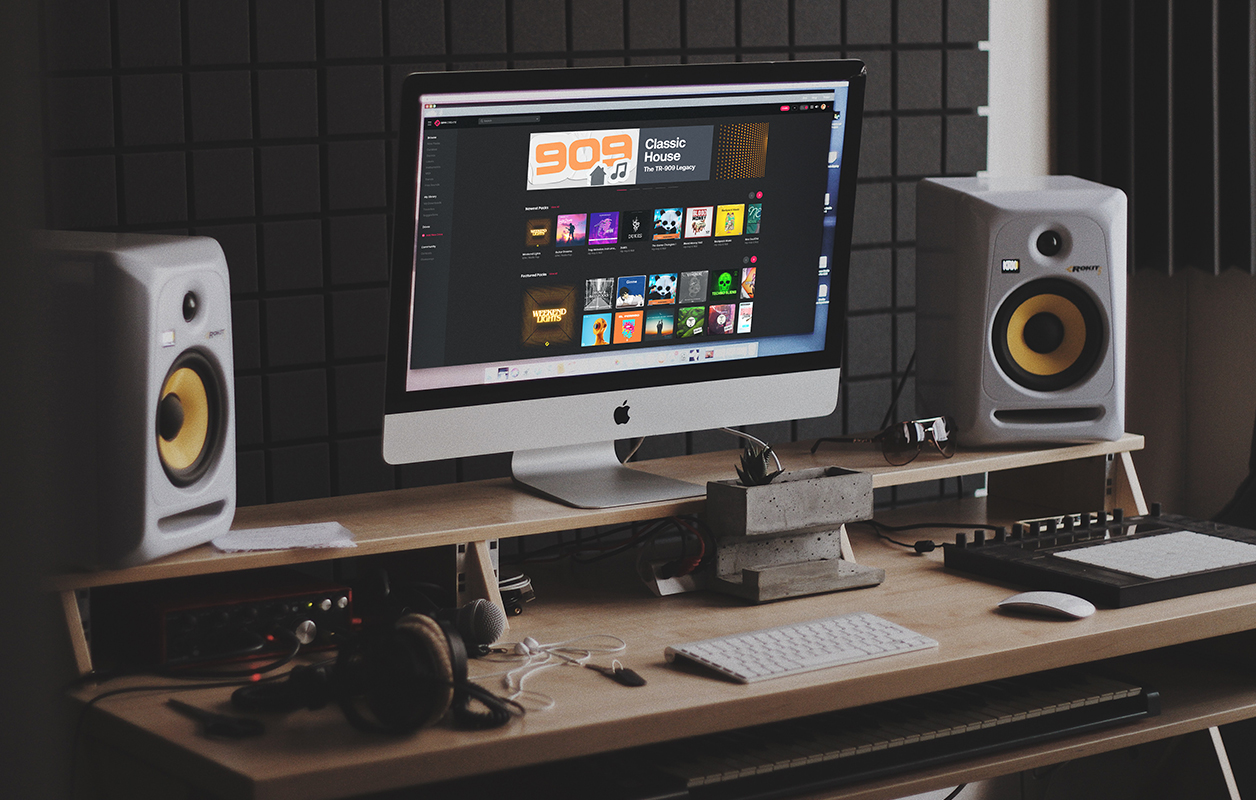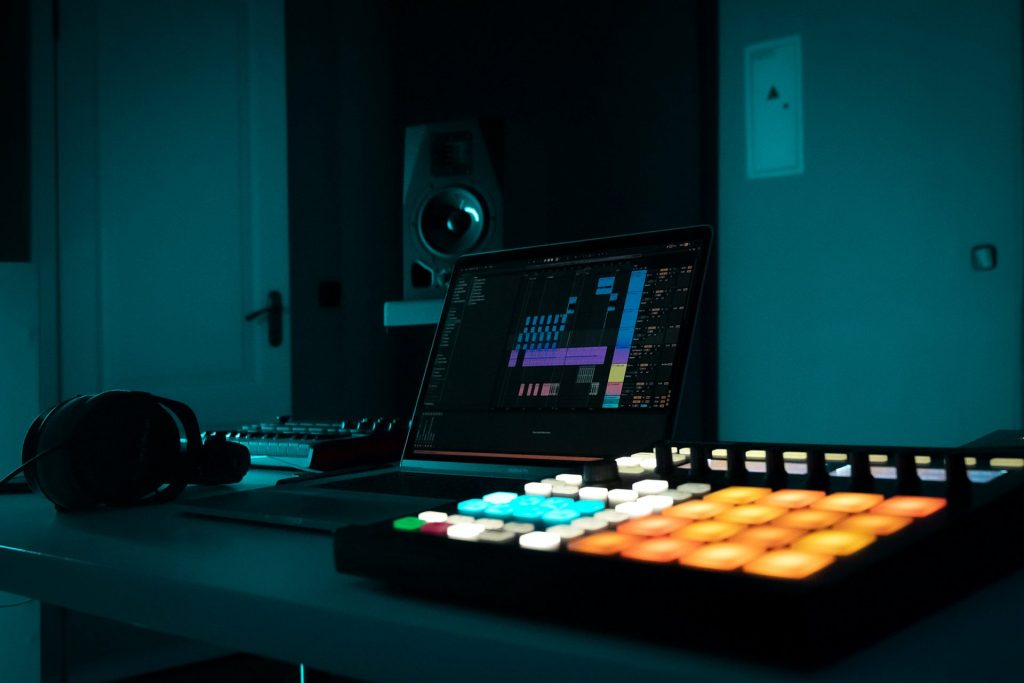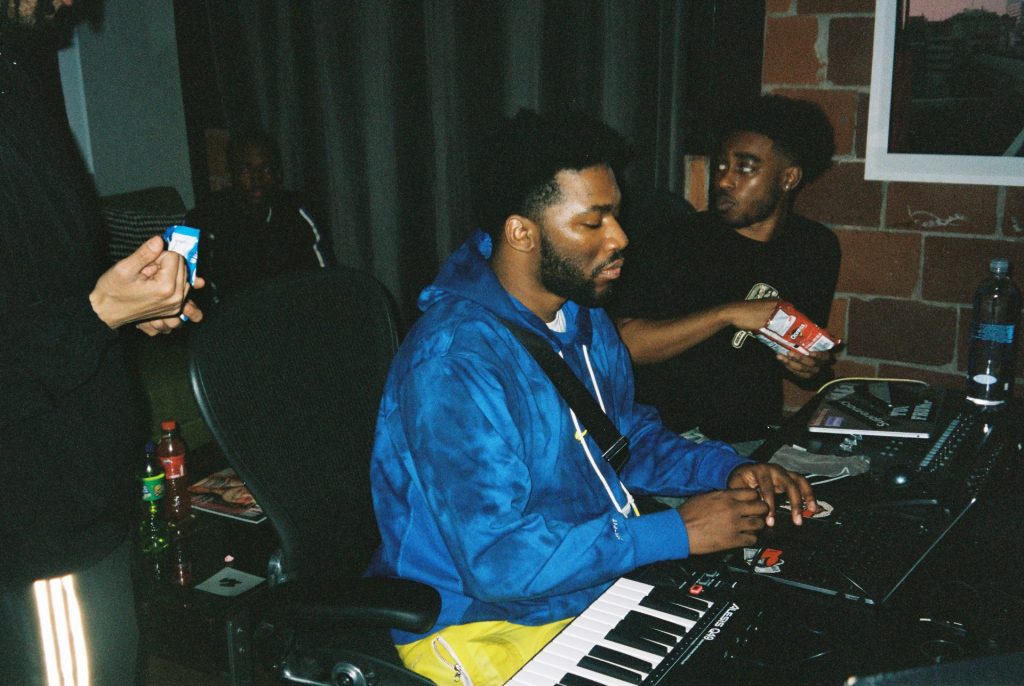
Are you ready to start producing music? Before you get going, there are a couple of music production essentials every producer needs to build beats.
Below, we’ll showcase the key elements of a music production setup so that you have a strong foundation for your music. You can always expand your gear collection as you go, but these critical pieces should be at the top of your list.

5 Music Production Tools Needed For Your DIY Studio
Without further ado, here are the five main elements of a basic music production setup. We’ll share some specific gear recommendations too, but note that these products can be swapped for other gear within the category that meets your budget and individual needs.
Also, note that our recommendations are primarily for newer producers, who might be opting for more budget-friendly gear than more experienced creators.
1. A Computer, Phone, or Hardware Production Piece
Above all, the most important piece of gear for any producer is your device for making beats. For most producers, this ends up being a desktop or laptop computer. However, if you’re just starting out and don’t have the means to get a computer for production, you can start by making music on your phone or tablet.
Some producers may prefer a hardware controller for making beats like an AKAI MPC or a Native Instruments Maschine MK3. Regardless of what beat station you choose, this tool is arguably the most important piece of your setup.
Cost Range: $500-$2000+
Recommendations:
If you’re going for a computer setup, it’s worth saving up for extra CPU and processing power, especially if you plan on using a lot of third-party plugins in your beats. Most smartphones can support mobile DAWs, though you’ll need plenty of storage to make room for your samples, virtual instruments, and project files. For a complete hardware beat station (note that standalone beat workstations can get pricey), check out tools like:
Blackbox sampling studio: $649
2. DAW
Your digital audio workstation, or DAW, is the software you’ll use to make and track your music. The good news is that many DAWs have a lite version or trial option to help make sure it’s a good fit for your workflow. You can also access entirely free DAWs like GarageBand as a Mac user, though note that cheaper or free DAWs often come at the expense of key features.
The industry standard is Avid’s Pro Tools, but you can certainly make radio-ready music on any DAW like Reaper, FL Studio, Ableton Live, Cubase, Logic – the list goes on! Whichever workflow and price point make the most sense for your beat making style is the right choice for you. Some basic hardware pieces (like the Scarlett interface mentioned below) come with software like Ableton Live Lite. You can also get education discounts for certain DAWs if you’re currently in school.
Cost Range: $0-$800
Recommendations:
We recommend trying out the free trial versions of different DAWs to find the best long-term DAW according to your tastes. That being said, here are two of the most affordable DAWs for beginners:
3. MIDI Controller
“MIDI” stands for Musical Instrument Digital Interface. Essentially, these are instruments that are fully mappable in your DAW or music production software. What that means is that you can use a controller to play any software instrument, whether it’s a synth sound or a sample pack of drums.
While you can technically get by without a MIDI controller (DAWs allow you to map controls to your computer’s keyboard), it certainly speeds up the workflow for any artist and a decent controller isn’t prohibitively expensive.
Cost Range: $40-$500
Recommendations:
To start, it’s best to find a controller with mappable pads and piano keys. If you’re into automation, prioritize a controller that comes with mappable mixing knobs. Check out models like:
4. Audio Interface
If you plan on recording vocals or live instruments, you’re going to need to use an audio interface. This piece of gear helps take the signal from an instrument or microphone and convert it into something your DAW can recognize. This hardware also allows you to listen to your beats via studio monitors or headphones. Audio interfaces often have built-in phantom power, too, which is used to power condenser microphones.
You’ll also need studio monitors and headphones to mix your tracks across the stereo field accurately. These specialized monitors and headphones are different than casual playback devices since they aim to produce the clearest depiction of sound, rather than what’s enjoyed the most by a listener. Without having accurate playback, you aren’t able to mix and improve your music properly, so these pieces of gear are essential.
Cost Range:
Interface: $50-$400+
Monitors: $300-$400+
Headphones: $100-$150+
Recommendations:
Interface: New producers need an interface that has phantom power, an instrument input, a microphone input, and an output for headphones and monitors. Check out models like:
Monitors:
New producers need monitors that provide a clear depiction of the stereo field without breaking the bank. Consider sets like:
Headphones:
You’ll be using your headphones a lot, so it’s best to invest in at least a mid-range model to keep you comfortable throughout long sessions. Consider the:
5. Microphone
Even if you’re not a vocalist yourself, it’s essential to have a microphone as a producer to jot down ideas and record organic sounds around your home studio. Opt for a traditional microphone rather than a USB or Bluetooth recording setup – either of these microphone types can cause unnecessary latency or delays in your recordings, so they aren’t a reliable pick for recording.
Fortunately, you can get a decent microphone on a budget. You’ll also need to invest in XLR cables to connect your microphone to your audio interface. If you’re using a condenser microphone requiring phantom power, you might need a microphone preamp as well if your audio interface doesn’t offer this support.
Cost Range: $100-$1000+
Recommendations:
Beginner producers need a versatile microphone like a condenser or vocal microphone that can record quality vocals without breaking the bank. Consider models like:

This list showcases some of the key pieces of gear for any producer just starting out. That being said, it’s important to remember that no singular piece of equipment is going to compensate for the time and effort you need to put into your music to succeed. Use this guide to build your bare-bones, core production setup, and start making beats!
The best way to learn is to start creating. As you progress in your career, it will become more clear which pieces of gear are essential and which are extraneous. After all, the best producers know that it isn’t necessarily about the equipment – it’s about the beat maker behind it.

